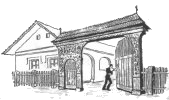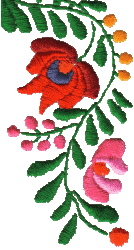History of the Szekely Kapu
Origins of the ancestral carved gates of Transylvania span thousands of years
before the Common Era (B.C.) and transcend beyond the boundaries of the
Carpathian Mountains to Mesopotamia and the Far East. Similar to the ancient
“Silk Route” that connected Central Europe to the Far East, these gates stood in
witness to civilizations from the great city of “Úr” in Mesopotamia and the Far
East.
This ancient art with a system of mythical symbols and richness of form is still
practiced and still inspires Hungarian Szeklers of Transylvania in creating
their home environment and preserving their traditions to this day. The
“Székelykapu” had symbolic meaning which separated East from West artistically
as well as geographically and politically. Most remarkably each gate was and
still is a unique individual work of art, one of a kind, but serving the same
practical purpose: keeping the “outside world” outside and guarding the
sanctuary of the home within. It is not by accident one finds the runic
inscriptions on front of the gate “The Lord has brought thee here” while on the
other side departing guests can read “The Lord be with thee”.
The word “Úr” translates as Lord and is carved exactly the same way as it can be
seen in the City of Úr photographed for the first time by Sir Leonard Wooley,
discoverer of the ancient Summerian City and author of several books among them
“Úr of the Chaldees” (London, 1950). His excavations revealed several motifs
carved into stone which are completely identical with leading motifs of
Hungarian but especially Transylvanian Folk Art such as the upward scrolling or
spiraling lines, tree of life, sun as central motif, runic symbols, five and
eight petal rose, pomegranate and cornflower.
Other gates that have withstood the ravages of time have been mostly carved from
oak as is the custom even today. In the top center under the roof and pigeon
loft, the traditional sign of the sun, symbol of Úr is carved and under it the
ancient greeting ISTEN HOZOTT. Besides individual decorations, the main post
which separated the large wagon gate from the small walk-in gate, displayed the
family history in runic writing (rovás irás). Each generation added it’s share
of history and when all sides were filled, a new supporting post was hewn from
oak and placed on either side of the walk-in gate. As runic writing became
obsolete, the custom of carving family history into the gateposts also faded
away. Besides the inherited symbols and decorations, only the greeting, name of
the homestead builder and date of completion was carved into the gate and
remains as tradition in our time.
With the gracious help of our Lord and the support of our membership, HCC of NEO
is planning to erect a traditional full size Székelykapu on our club grounds.
This long awaited dream will hopefully come to fruition this summer and will be
a celebrated addition to our club’s life for many years to come.
|
|
|


